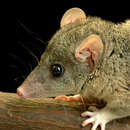en
names in breadcrumbs


Gray short-tailed opossums vocalize when threatened or approached by a possible mate. A series of chirps or barks is used to advertise threat level. Olfaction also plays an important role in the lives of gray short-tailed opossums; scent marking is used for territorial purposes and for assessment of reproductive condition of females.
Communication Channels: visual ; acoustic ; chemical
Other Communication Modes: pheromones ; scent marks
Perception Channels: visual ; tactile ; acoustic ; chemical
Monodelphis domestica is both common in the wild and in the pet trade.
US Federal List: no special status
CITES: no special status
IUCN Red List of Threatened Species: least concern
Monodelphis domestica can invade human dwellings and become an annoyance.
Negative Impacts: household pest
Gray short-tailed opossums have become a popular species in the exotic pet trade. They are important in research because they are one of the few animals to get skin cancer at a rate similar to humans. Gray short-tailed opossums are at the top of the list for full genome sequencing. Dozens of research projects are currently being done with M. domestica.
Gray short-tailed opossums are often welcome visitors in human households, as they consume insects, scorpions, and other pests.
Positive Impacts: pet trade ; research and education
Gray short-tailed opossums are insectivores and negatively impact insect populations where they occur. No list of predators which feed upon M. domestica has been published; however, they are likely part of the diets of other mammalian carnivores, such as other didelphids, and large birds of prey. Monodelphis domestica also acts as a host for a variety of parasites, such as the echinostomatiform protozoan Rhopalias dobbini.
Commensal/Parasitic Species:
Gray short-tailed opossums are omnivorous, eating insects, fruits, and small animals, such as rodents.
Animal Foods: mammals; insects; terrestrial non-insect arthropods
Plant Foods: fruit
Primary Diet: omnivore
Monodelphis domestica is found throughout the forests of Brazil, Bolivia, Argentina, and Paraguay.
Biogeographic Regions: neotropical (Native )
Gray short-tailed opossums are found in tropical forests, scrublands, and grassy areas, on the ground or in low level vegetation. As with other short-tailed opossums (Monodelphis), gray short-tailed opossums may inhabit human dwellings, where they feed on small rodents and insects.
Habitat Regions: tropical ; terrestrial
Terrestrial Biomes: savanna or grassland ; forest ; rainforest ; scrub forest
Other Habitat Features: suburban ; agricultural
Just over six years seems the most agreed upon upper lifespan in captivity. In the wild, two years is the standard lifespan.
Range lifespan
Status: wild: 3 to 6 years.
Average lifespan
Status: wild: 4 years.
Range lifespan
Status: captivity: 6 to 10 years.
Typical lifespan
Status: wild: 1 to 3 years.
Typical lifespan
Status: captivity: 2 to 6 years.
Monodelphis domestica is a member of the group of short-tailed opossums, Monodelphis, which are some of the smallest didelphids. Body length of adults ranges from 10 to 15 cm. Adult males weigh between 90 and 155 g, females are between 80 and 100 g. Most individuals have light grey fur, but fur color does vary, with some popluations having more reddish or whitish fur. Their tails are naked, rat-like, and semi-prehensile. Tail length varies but is usually about half the length of the of body.
Range mass: 90 to 155 g.
Range length: 10 to 15 cm.
Other Physical Features: endothermic ; homoiothermic; bilateral symmetry
Sexual Dimorphism: male larger
Average basal metabolic rate: 0.335 W.
Specific information on predators of M. domestica was not found. Harpy eagles (Harpia harpyja), other birds of prey, and other predatory mammals are likely predators. Gray short-tailed opossums are cryptically colored and secretive, thereby avoiding some predation.
Anti-predator Adaptations: cryptic
Mating behavior in M. domestica is strongly tied to olfaction. Males habitually mark their surroundings with a chemical mark produced by a sternal gland. This scent likely serves as an advertisement to local females and a warning to local males. When a male and a receptive female meet, a precopulatory dance of sniffing, chasing, biting, and licking ensues. At the completion of this dance, the male immobilizes the female's hind legs and begins copulation, which lasts from 4 to 7 minutes. The majority of matings take place with the animals laying on their right sides.
Mating System: polygynandrous (promiscuous)
Sexual maturity in M. domestica is reached by 18 to 20 weeks. Gestation lasts 14 to 15 days and females can have up to 5 litters per year. Typical litter size is from 7 to 9.
Breeding interval: On average gray short-tailed opossums breed 4 times per year.
Breeding season: In the wild, breeding occurs most often during the spring and summer months, when daylight hours are the longest.
Range number of offspring: 1 to 15.
Range gestation period: 14 to 15 days.
Range weaning age: 3 to 4 weeks.
Average weaning age: 3 weeks.
Range time to independence: 6 to 8 weeks.
Range age at sexual or reproductive maturity (female): 5 to 7 months.
Range age at sexual or reproductive maturity (male): 5 to 7 months.
Key Reproductive Features: seasonal breeding ; year-round breeding ; gonochoric/gonochoristic/dioecious (sexes separate); sexual ; induced ovulation ; viviparous
Average birth mass: 0.1 g.
Average number of offspring: 9.
Immediately after birth, newborn M. domestica crawl to their mother's stomach and attach to a nipple. They remain attached this way for 3 to 4 weeks. After detachment the young climb on their mother and/or follow her around for another three months or more. Paternal care in M. domestica is nonexistent, moreover, in captivity when fathers are confronted with their offspring, they act aggressively towards them.
Parental Investment: altricial ; pre-fertilization (Provisioning, Protecting: Female); pre-hatching/birth (Provisioning: Female, Protecting: Female); pre-weaning/fledging (Provisioning: Female, Protecting: Female)